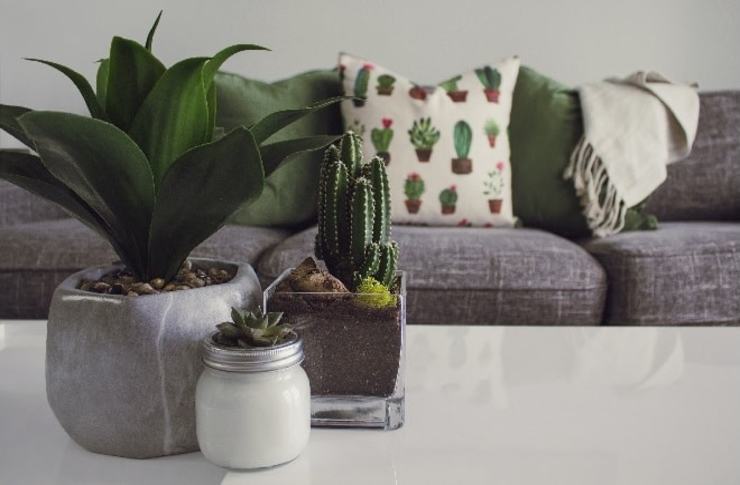5 Best Houseplants for Cleaning the Air
People who’ve never owned a houseplant may be nervous of buying one because they fear they’ll kill it in short order. This doesn’t have to be true. Indeed, many houseplants don’t require pampering, and some even seem to thrive on neglect. Not only this, a lot of these easy-to-grow plants have been recommended for relieving anxiety, lowering blood pressure, easing pain and pulling pollutants out of the air. The novice plant owner can start with one or two easy plants and graduate up to plants that are a bit more challenging as they gain confidence. Here is a list of some of the best houseplants for cleaning the air:

1. Snake Plant
This is one of the plants that has a reputation for being just about unkillable as well as scrubbing the air of volatile organic compounds, or VOCs. This plant, with its lance-shaped, green and gold striped leaves, can stand low light, low water and poor potting soil. However, if it’s well taken care of it produces lovely white flowers borne on spikes. Some houseplant tips if the owner wants to one day see these flowers are to grow the plant in good, well-draining soil in a terra cotta pot with a drainage hole and to not overwater the plant. Indeed, some experts recommend that the snake plant not be watered at all in the winter months.
The snake plant also does best in indirect light and can benefit from an all-around plant food during the summer.
2. Pothos
The pothos is just the thing for a hanging basket, for it has beautiful, trailing, variegated, heart-shaped leaves. Like the snake plant, it is hard to kill. It’s especially good at cleaning the air of benzene and formaldehyde as well as carbon monoxide.
Houseplant tips for the pothos include placing it in well-draining, average potting soil and placing it in bright, but not direct light. Pothos plants have been known to grow even in dark rooms, and if they get too much sunlight, the leaves grow pale and listless. It’s a light feeder and needs to have its soil dry out completely before it’s watered again, so it doesn’t mind if the owner skips a watering or two or three.
3. Jade Plant
The jade plant is a succulent, a symbol of good luck and a good plant to keep the air clean. The fleshy, ovate leaves store water, as do the stems, so the plant doesn’t need much watering. It can also grow well in a room that’s too cold for other houseplants, and if it’s well cared for produces masses of pinkish-white, fragrant blossoms in the winter.
Jade plants need at least four hours a day of full sunlight, so they’re best grown in a window with a southern exposure. Though they’re succulents and can do well if the owner skips a watering, they need enough water to keep the soil a bit moist and need to be in a pot with good drainage. They thrive in cactus mix and must never have “wet feet.” The jade plant only needs to be watered once a month during the winter.
Fertilize the jade plant at the beginning of the growing season or give it a light feeding every week or so. A good type of fertilizer for a jade plant is a 20-20-20 fertilizer used at one quarter strength. 20-20-20 means it’s 20 percent nitrogen, 20 percent potassium and 20 percent phosphorus.
4. Bromeliads
Bromeliads are related to pineapples, and the leaves of some species look like the leaves of snake plants. The difference is that a well-cared for bromeliad can sprout amazing, neon-bright flowers that persist for months. Bromeliads are exceptionally good at cleaning VOCs out of the air, according to a NASA study.
Like jade plants, bromeliads don’t like wet feet, and it’s better to underwater them than overwater them. A bromeliad must be planted in a medium that allows for good draining and shouldn’t be watered until the soil is dry. The owner should be careful to fill the plant’s tank with water. This is the cup formed by the leaves of the plant. Bromeliads also need high humidity and should be misted regularly.
The plants should be placed in terra cotta pots, and watering and misting cans should not be made of metal, for even tiny amounts of metal in the water can hurt the plant. Though different species have different light requirements, the owner can’t go wrong to put their bromeliad in an area that gets bright but not direct sunlight. The plant is also a light feeder, but fertilizer needs to go directly into the soil and never in the tank.
The bromeliad flower can be spectacular, but the plant blossoms only once in its life then dies. The good news is that the plant also produces pups that can be placed in their own pots and continue the life cycle.
5. Spider Plant
This is another easy houseplant meant for hanging baskets. Uniquely beautiful with pale green and white stripes, it grows long stems that sprout spiderettes that can be snipped off and grown in their own pots. The spider plant is good for clearing the air of formaldehyde.
The spider plant can take a lot of neglect, but it will do best in a pot with well-drained soil and bright but not direct light. They like to be well-watered but do not like wet feet and like the soil to dry out before they’re watered again. Like the jade plant, the spider plant flourishes in cooler temperatures.
The plant prefers to get a bit pot-bound, so it shouldn’t be repotted until the owner can see the roots, and the plant becomes hard to water. Spider plants can be easily propagated through their spiderettes.




